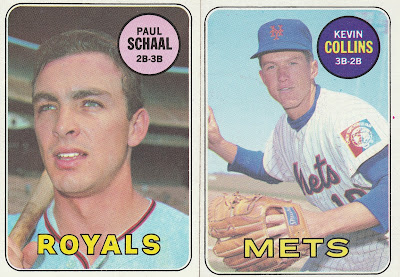The 1969 Topps set had 664 cards, but since there were two distinct versions of the C Clay Dalrymple and 1B Donn Clendenon cards (not just printing errors), the actual set size is 666. (Those 2 players have been counted twice in this exercise.)
For the first time in many years, the set did not include any team cards. There are 25 manager cards (2 for the Senators), 52 rookie stars cards (none for the Senators), 20 all-star cards, 12 league leaders, 8 World Series cards, 4 multi-player cards, and 7 checklists. There are also 538 cards of individual players.
Here is the position breakdown of the 538 player cards:
219 cards for "Pitcher"
52 cards for "Catcher"
24 cards for "1st Base"
27 cards for "2nd Base"
25 cards for "Shortstop"
24 cards for "3rd Base"
17 cards for "Infield"
106 cards for "Outfield"
That's a total of 494 cards. The remaining 44 cards featured players at more than 1 position. Below is a sample of each position:
After several years as a "1B-C" for the Cubs, John Boccabella has a new team and a new position! He is joined at C-1B by Jack Hiatt (of course) and Don Pavletich. Boccabella's old job as the lone 1B-C in the Topps set is filled by Joe Torre.
With Tom Satriano now strictly a catcher and Ozzie Virgil retired, there are no C-3B or 3B-C players in the set. The new trend is combining C and OF. Bob Watson's rookie card shows him as the lone C-OF. George Thomas and the Pirates' Gary Kolb are the OF-C cards.
Ken Harrelson leads the group of five 1B-OF, along with Tommie Aaron, Tom McCraw, Mike Hegan, and the Giants' Bob Burda.
Frank Howard is 1 of 4 players at OF-1B (with Tito Francona, Jim Beauchamp, and Art Shamsky).
Don Buford is the lone representative for 2B-OF. Hank Allen and the Expos' Jose Herrera have the opposite position.
In my 1968 post, I lamented Topps' decision to portray Gary Sutherland as INF-OF, instead of the more accurate SS-OF. In the 1969 set, that combination appears, but only for these 2 cards.
Longtime Tigers' center fielder Mickey Stanley played shortstop in the 1968 World Series, and for the first part of the 1969 season, until he returned to center field when the Tigers acquired.... Tom Tresh!
For the 2nd time in 3 years, Bob Bailey is labelled as 3B-OF. This year he is joined by Cesar Tovar and Pete Ward. Bob Aspromonte is the only OF-3B in the set.
Tim Cullen reprises his 1968 position, also with Al Weis, Paul Popovich, and Tom Matchick. Denis Menke and Roberto Pena are the two with SS-2B.
Paul Schaal and Jim Lefebvre are the two cards showing 2B-3B. Kevin Collins is by himself at 3B-2B.
Here's another new combo - SS-1B! These are the only 2 cards for these positions, and there are none for the opposite combo.
Ken Boyer heads up a list of 5 players with the 3B-1B position (tied for the most with 1B-OF). Also George Scott and Dalton Jones (BOTH on the Red Sox), Harmon Killebrew, and Deron Johnson. (There are no cards for 1B-3B.)
And last
A few weeks ago I realized there was no Rookie Stars card for the Senators. During my research for this post, I discovered that there are only 6 pitchers for the Expos and 7 for the Padres and Athletics. (Most teams have 9 to 11 pitchers.) Also, there is only 1 catcher for the Braves, Padres, and Red Sox, and only 3 outfielders for the Cardinals.
Another oddity is that aside from 1st baseman Wes Parker, the Dodgers had no other infielders with just one position on their card.
When looking at total cards per team, the Phillies and Padres only had 19 cards (2nd year in a row that the Phillies had the least number of cards!), and the Red Sox only had 20, while most teams had 23 to 25 cards.
The post for the 1966 and 1970 sets will follow soon, but since I am missing several dozen cards from each set, I will need to use something else for reference, like this.
.














.jpg)

.jpg)



















